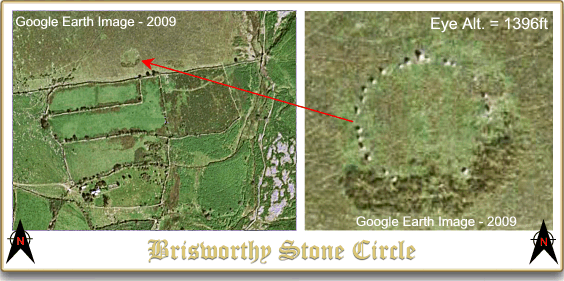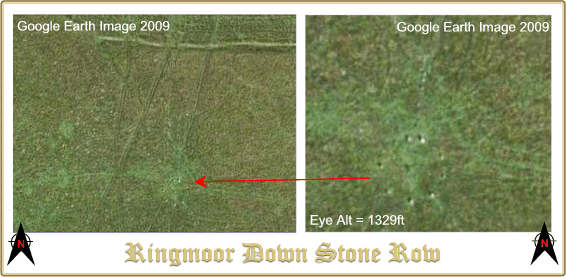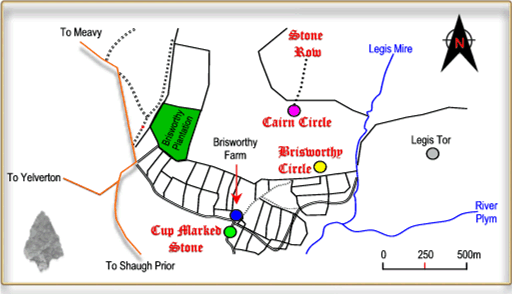

‘The circle is one of the finest on Dartmoor, although the Grey Wethers and Scar Hill (Scorhill) are larger specimens. The diameter is about 80ft (24.38m) and it consists of twenty four stones; originally all except three lay prostrate on the ground, until the summer of 1909, when Mr. R. Hansford Worth and I re-erected the stones of this beautiful monument. Several stones are missing on the south side, which are evidentially in the wall near by… Excavations in the centre disclose the presence of wood ashes and charcoal.’, (Breton, 1990, Part 1 pp. 51 – 52).
Baring in mind that this book was first published in 1911, here is one very nice aside to this tract and that is where Breton points out to the prospective sightseer that, ‘Mrs Hamlyn, at Brisworthy Farm, will provide tea for visitors‘. who says farm diversification is a new idea? About 70 years later Eric Hemery included a very brief description in his book – High Dartmoor:
‘On Brisery (local for Brisworthy) Down, south-east of the track that leads to Ditsworthy, stands Brisworthy done circle; this splendid monument, with twenty-seven stones erect and a diameter of seventy-nine feet, was restored by Hugh Breton and Hansford Worth in 1909.’, Hemery, 1983, p.185).
As can be seen, the stone circle seems to have proliferated as, according to Hemery, it gained three extra stones and shrunk 1ft in diameter. Today the circle consists of 24 upright stones with the largest measuring 1.4m x 0.9m x 0.7 high and the smallest at 0.3m x 0.6m x 0.2m high. The mean interval diameter of the circle is 24.0m which is remarkably even spacing. Most writers agree that the restoration work carried out in 1909 was of a very accurate nature so basically what you see today is pretty much as it would have been 4,000 years ago. Breton mentions that an excavation of the centre of the circle was carried out and the evidence for this trench can still be seen, but what Breton did not mention was that along with the wood ash and charcoal a single rough flake was also found, (Butler, 1994, p.134).

The two aerial photographs above clearly show the location and an aerial view of the circle which also admirably indicates the problem of encroaching vegetation on Dartmoor’s antiquities. Fortunately the gorse had been removed when I visited the circle in May 2009 as can be seen from the photographs below. As always, nobody knows exactly what the purpose of stones circles was but in the case of Brisworthy Burl surmises that it was a focal centre for the various settlements dotted around its vicinity, (Burl, 2000, p.151).
|
Spot the Circle |
|
Brisworthy Circle |
|
Brisworthy Circle |
|
Brisworthy Circle |
There is also a tradition on Dartmoor that treasure is buried somewhere in the area around Brisworthy circle:
‘The old tradition of buried treasure which is related of so many places is attached to Ringmoor Down. It used to be said that if this could be discovered “all England might plough with a golden share.” ‘, (Crossing, 1990, p.450).
From the above, one gets the impression that for all of England to prosper so greatly the treasure hoard must be vast but before anyone goes charging out there with shovel in hand it should be remembered that none of these tales have ever revealed to tiniest grain of gold. This assumption has always been based upon the theory that it was the wealthy tribal leaders that were buried in the cairns and kists along with their treasures. This idea is now known to be true but what they regarded as ‘treasures’ were, in most cases, made of flint, stone or bone. Sadly, these traditions have in the past led to many of Dartmoor’s prehistoric graves being rifled in a futile attempt to locate the burial goods by tomb raiders.
If you ever visit Brisworthy then there are a couple of other prehistoric features within a 300 metre radius of the circle which would be a pity to overlook. The first is a cairn circle, the second an associated stone row and the third is a cup marked stone.

Again this cairn circle has been subjected to some early restoration carried out in 1909, the result of which has been severely criticised by Richard Hansford Worth. Prior to the work there reportedly was but one single stone standing along with four fallen stones and evidence of supposed socket holes for six missing stones. Accordingly the fallen stones were re-erected and six stones ‘imported’ from elsewhere to stand in the presumed socket holes. It has been suggested that the original stone circle only comprised of five stones which means what stands today is a complete misrepresentation, (Bulter, 1994, p.143). The cairn which stands inside the circle is 12.6m in diameter and stands about 0.4m high, again the feature shows signs of being ‘excavated’ at some point.

The stone row runs northwards from the cairn circle and thanks to some medieval ridge and furrow ploughing now consists of two parts consisting of a single row. Again the row was the subject of restoration work in 1909 which has been described as inaccurate to say the least. Prior to restoration there were very few stones standing for the initial 300m and the fallen stones in some cases were simply re-erected where they stood. Sadly, it has been estimated that at least seven of these stones were re-erected several metres too far to the west and are now misaligned as were some others further north in the row. The only stones that can be said to be in their original location are those which stand in the last 75m of the north end of the row, (Butler, 1994, p.143). None of the existing stones stand above a metre high and many of them only just manage to protrude out of the ground. It is apparent from the many gaps in the row that at some point the missing stones had been removed, English Heritage suggest that these had been ‘recycled’ for use in the building of the nearby medieval longhouses.

The last feature is actually built into the field wall about 600m to the south west of Brisworthy Circle, originally this large block of undressed granite was thought to have been a tinner’s mortar stone but recent thinking now classifies this feature as a prehistoric cup marked stone. There are 15 cup marks which vary in diameter from 40 to 80mm and 5 – 25mm deep along with some other possible examples. The boulder can be found on the east side of the farm lane near to the entrance of Brisworthy Farm. This is but one of only three cup marked stones found on Dartmoor (possibly even two as one of them has been reclassified by English Heritage as a tinner’s mortar stone).
|
Stone Row |
|
|
|
Medieval Ridge & Furrow |
|
The day I visited the features was a good day for walking with a stiff breeze blowing from the south west, not a soul in sight and all the smells and sounds of the moor everywhere. There was a green woodpecker somewhere in Brisworthy Plantation busily singing away with it ear piercing ‘whip, whip whipping’. Below in the Brisworthy enclosures a cuckoo was making its presence know with the ever evocative call of Spring. Also somewhere in the enclosures a cock pheasant was strutting around nonchantly clucking away safe in the knowledge that the shooting season is over.

Reference.
Breton, H. 1990.Beautiful Dartmoor, Forest Publishing: Liverton.
Burl, A. 2000. The Stone Circles of Britain, London: Yale University Press.
Butler, J. 1994. Dartmoor Atlas of Antiquities – Vol. III, Tiverton: Devon Books.
Crossing, W. 1990. Crossing’s Guide to Dartmoor, Newton Abbot: Peninsula Press.
Hemery, E. 1983. High Dartmoor, London: Hale Publishing.
 Legendary Dartmoor The many aspects past and present of Dartmoor
Legendary Dartmoor The many aspects past and present of Dartmoor













One comment
Pingback: Brisworthy Stone Circle | Dartmoor Hiking